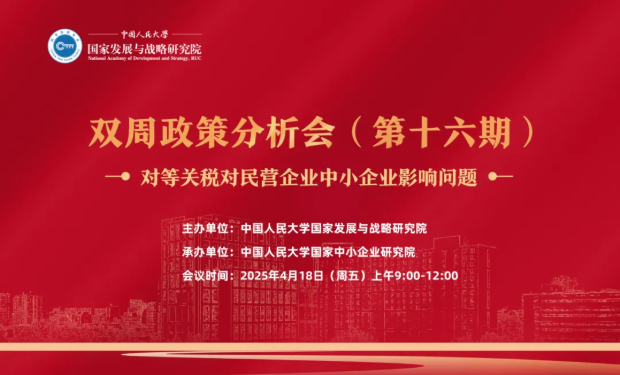 Research Update
Research Update
08
May

In response to the challenges posed by tariff changes on businesses, the 16th Biweekly Policy Analysis Meeting—titled “The Impact of Reciprocal Tariff Policies on Private and Small and Medium-sized Enterprises”—was held on April 18, 2025. The event was hosted by the National Academy of Development and Strategy at Renmin University of China and organized by the National Institute for Small and Medium Sized Enterprises at Renmin University of China. The seminar was chaired by Professor SUN Wenkai, Research Fellow at the National Academy of Development and Strategy and Deputy Director of the National Institute for Small and Medium Sized Enterprises. Experts and representatives from academia, government sectors, and industry engaged in in-depth discussions.
Experts at the meeting agreed that the reciprocal tariff policy introduced by Trump administration is expected to directly impact the direction and scale of Chinese enterprises’ exports, while also indirectly triggering structural adjustments in employment and industry. From an overall perspective, experts believe that the implementation of the tariff policy has had a significant impact on China’s private and small-to-medium-sized enterprises (SMEs), but the U.S. side’s tariff strategy is unsustainable. The imposition of it poses short-term pain for SMEs, which may be resolved in the near future; however, the broader trend of U.S.-China decoupling and U.S. containment of China is viewed as a long-term development.
In terms of scope and mechanisms of this impact, some scholars argue that reciprocal tariffs transmit through the industrial chain, affecting upstream sectors and central regions of China. High tariffs increase production and operational costs for enterprises, sharply reduce overseas orders, and may lead to the relocation of industrial chains, giving rise to a series of employment and livelihood issues.
As for coping strategies, enterprises should proactively adjust their business models, diversify their sales channels and export structures, enhance R&D efforts, and focus on product variety and quality—turning crises into opportunities. From a policy standpoint, experts recommend targeted measures for affected sectors and regions, avoiding a “one-size-fits-all” approach. Specific measures include encouraging local governments to explore new markets, expanding the domestic market, boosting consumption, leveraging time lags in tax-free small parcel exports, implementing reciprocal tariff exemptions for imports, and resolving inventory backlogs.
Business representatives at the meeting also expressed expectations for supportive government policies. They hope the government will provide some space through tax and fee reductions, export credit insurance, and tax rebates, while also assisting enterprises in identifying alternative import-export channels, easing financing restrictions, promoting domestic substitution in highly U.S.-dependent industrial chains, and supporting the development of specialized markets. They also called for timely and flexible policy adjustments.
(The above views are compiled from the statements made by participants at the 16th Biweekly Policy Analysis Meeting held on April 18, 2025. It is intended solely for academic exchange and does not represent the views of the National Academy of Development and Strategy, Renmin University of China.)
Proofread by ZOU Jingxian, SUN Wenkai
Translated by ZHANG Yuqing
Edited by ZHANG Jingjing